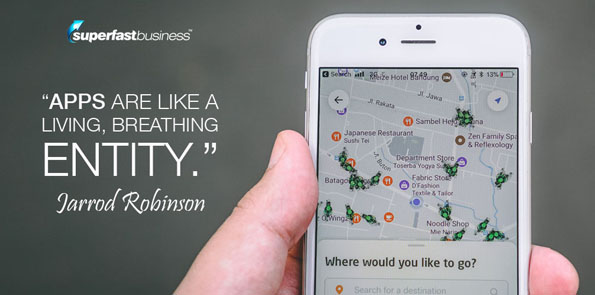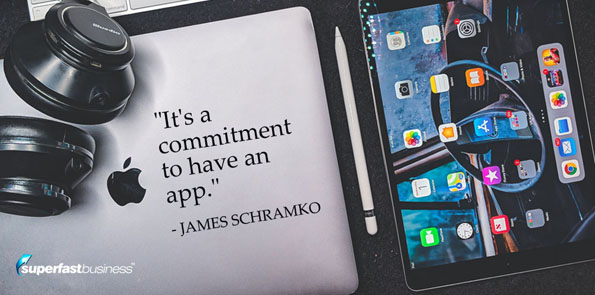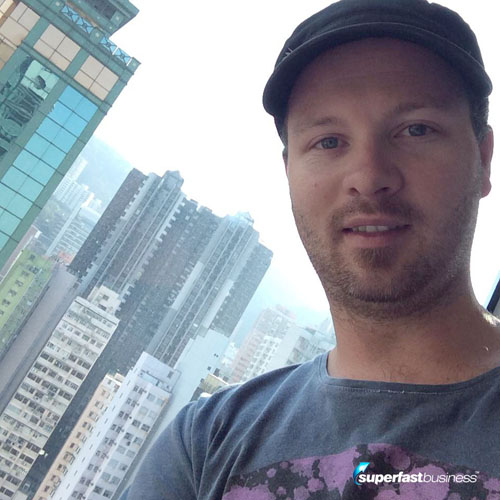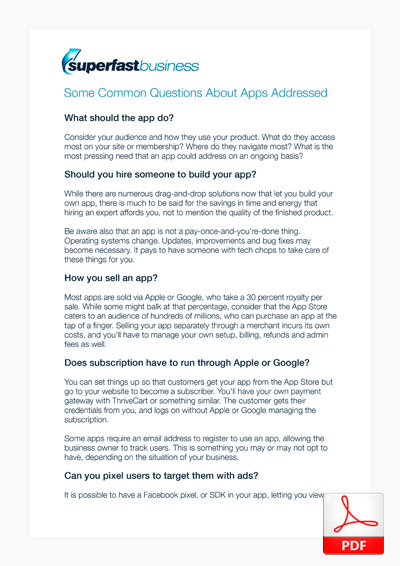Podcast: Download (Duration: 19:28 — 18.0MB)
Get Notified Of Future Episodes Apple Podcasts | Spotify | Amazon Music | Android | Blubrry | Gaana | TuneIn | Deezer | Anghami | RSS | More
Episode highlights:
01:23 – A well-received version
02:51 – Delivering what people want
04:36 – Should you get someone to build your app?
07:13 – An ongoing thing
08:46 – Selling an app
11:32 – Does it have to go through Apple?
13:43 – Pixels and ads
14:22 – Why make a free app?
16:29 – What else to sell to app users
Stay on top of the latest online business trends with James’s personal coaching
Transcription:
James: James Schramko here. Welcome back to SuperFastBusiness.com. This is Episode 634. The topic is apps explained. For this, I’ve brought along my special guests and technological superstar, Jarrod Robinson. Welcome back.
Jarrod: Thank you, James. Pleasure to be here again.
James: This is part of our Tech Series, where we’re talking about tech. We did Episode 611, which was called The Current State of Apps, which was a great overview, well worth listening to if you want to get into this realm of apps.
Today, we’re going to cover some of the frequently asked questions, some of which came from the first episode we did. As a result of that episode, we’ve got a couple of questions. We’ve got plenty of people inside SuperFastBusiness talking about apps.
A well-received version
And of note, recently, we pushed a new version of the SuperFastBusiness app, and that would probably be a good starting point to talk about what we pushed out there to members. And maybe even let’s start with what does push mean? Because that’s a tech term that maybe not everyone’s across.
Jarrod: Yeah. Well, typically in this setting, it means pushing some new code out to, like, a user base. So we did that recently with the SuperFastBusiness app and rolled out a much more improved user experience focused around the actual problem that SuperFastBusiness people have, which is, how do we get them into the forum as easy as possible?
So that is what this new version of the app focused on, when previous versions sort of focused on maybe having some of the other features like the podcast and the blog and videos and so on. So we removed that stuff, stripped it back to what it is that people really wanted, which is just a simple, really fast posting and reading experience. And as a result, we’ve gotten the new SuperFastBusiness app which everyone seems to be really, really enjoying.
James: Yeah, it’s really quite different this time. Instead of having the podcast and different menu items, it’s really only designed for people who are members.
Jarrod: Yeah.
James: And it’s their way of accessing the membership. It loads much faster. And it’s simpler. There’s less stuff. It’s kind of like my old app went on to KonMari course, did the magic of tidying up the app, and it’s ended up just neatly rolled and only what you need in the right place. So it’s nice and simple.
Delivering what people want
Jarrod: It definitely speaks into that, you know, the idea that this stuff is like this ongoing process. And when you build an app, it’s not like, done, you never have to think about it again. But you know, we have to look at what, in your case, your members are doing and what they want. And when we see that most of them are only ever using it to access the forum, then that’s what we should really build for them as the main feature.
“Double down on the winners.”
James: It’s like doubling down on the winners. It’s like, what do people use? I actually track, inside my community, I track the navigation items. And when I find one’s more popular, we move that to the first menu preference so that people, especially people using the desktop version, will get the navigation menu that they use the most in the highest usable spot.
This app is what we call a native app. Basically, it integrates as much as possible with the software that I use to run the forum.
Jarrod: Yeah, pure and native. And we’ve got some cool features about to be released, so that, you know, let’s say you send a newsletter to your audience, like the members’ newsletters, which are the highlight of my week, seeing stuff that comes through. Well, they’ll be able to click the links and be prompted with, Do you want to read this in the browser or have it open in the mobile app? where they won’t have to, you know, really do anything. They’ll just be there in one click.
 So by native, we can make the experience even better for members. And that’s sort of, you know, the whole idea, like apps are this ongoing process of, are you serving people in the best way? And we get a lot of questions around that.
So by native, we can make the experience even better for members. And that’s sort of, you know, the whole idea, like apps are this ongoing process of, are you serving people in the best way? And we get a lot of questions around that.
James: Well, the thing is, people are using their phones and tablets a lot more than they used to as well. And if you want to use the community the way you normally use it on a desktop, you can still use it on a browser on a phone. So you could open up Chrome or Safari and use the forum with all the same features, the search features, the different sort of display. If you want the very streamlined, simple version, the app is the way to go.
Should you get someone to build your app?
Now I should also clarify, when you say we’re doing this, or we’re doing that, you’re talking about TheAppMatch.com, which is your business supplying apps. And I think what you just said is a great answer to one of the questions, which is, should you be building your app yourself using one of those drag-and-drop app-building tools, or should you get someone to build it for you? Why would you pay a little bit more to get someone to do it for you?
I’ll go first. Firstly, I’ve tried before. In the very beginning, I think I spent five grand and didn’t end up with much of an app, with an in-house resource that was a nightmare. I don’t know how many versions we’ve had, Jarrod, but we’ve had probably six or seven?
Jarrod: Yeah, yeah. We’ve been through quite a few.
James: Eight, maybe, since we’ve been working together? And I gotta say, I really like just being able to send you an email saying, “Hey, Jarrod…” Or you send me an email, is actually more often the case. You say, “Hey, we’ve got a new version. I’d like to update.” And I say, “Go for it.” And we do it, and then we wait. We sit back and we wait for the members. The members are everything. Remember, one app we pushed out, they didn’t like it, and we rolled it back to the previous version.
Jarrod: Yeah, they were ruthless, ruthless with that one.
James: But this one, they love it. They’re like, “Love the new app.” “The new version is far better with usability.” “Well done.” So it’s like, oh, thank goodness, the members like it. And the test, of course, is when I use it, when I use the app to manage my own forum, because I’m still the most prolific user of my own community. No surprise there. And I love it.
So that’s one reason to do it. If you just don’t want to do it, you don’t know how to do it, you suspect that it’s going to need changes and updates and upgrades, which I’m pretty certain it will for a long time, you probably want to get it in the hands of an expert.
 Jarrod: Well, you’ve summed it up pretty well. Because, you know, at the end of the day, you’ve got the things that bring your return on investment, the stuff that you do best, your expertise, and I don’t think software development probably fits into that at this point in time. So, you know, the thing that is for sure is that there are changes and they need to be addressed, and apps are like a living, breathing entity.
Jarrod: Well, you’ve summed it up pretty well. Because, you know, at the end of the day, you’ve got the things that bring your return on investment, the stuff that you do best, your expertise, and I don’t think software development probably fits into that at this point in time. So, you know, the thing that is for sure is that there are changes and they need to be addressed, and apps are like a living, breathing entity.
And it’s been good that me being in your membership, I’m able to see what people want from the app, and as a result, we get to iterate and build out features that people are actually going to use. And, you know, that’s the most important thing, like, being receptive to the changes that people want and treating this as like a living, breathing entity.
James: The other thing is, an agency like yours who’s seeing a lot of use cases is going to know a lot more than an individual can gather. Like, you can either lean on the learnings of someone who’s seen it all and exposed to it all, or try and figure it out yourself, which is a slow and expensive and difficult way to do it.
Jarrod: Yeah.
An ongoing thing
James: So, talking about ongoing costs, it’s not a pay once and you’re done type thing, because there are ongoing changes required. Like, in the background, you’re always keeping abreast of updates and changes. Occasionally, I have to accept new terms and conditions in the Apple developer or Google, when they want to change the way they’re going to use technology. Sometimes that requires an update. So it makes sense that there is an ongoing fee, and that includes things like bug fixes and software updates and making sure that everything’s running smoothly.
“It’s not a pay once and you’re done type thing.”
Jarrod: Yeah, for sure. I mean, I would usually say to people, if they’re not comfortable with this idea of having another subscription, because we do get this subscription overload, you probably wouldn’t go down the path of having or building an app. Because they aren’t this idea of, yeah, let’s put up an app and and that’s going to last forever. You’d probably be really disappointed to find that in six months’ time when Apple roll out their new, you know, iOS 13, your app no longer ceases to function. So as a consumer, we love it when these things change. But as a developer, it’s certainly a bit more of a challenge.
 James: Yeah, I can’t tell you how many times I’ve seen an app on my phone, just like, uploading. It’s a constant reminder of, technology, it’s all moving and changing. So you’re right. It’s a commitment to have an app.
James: Yeah, I can’t tell you how many times I’ve seen an app on my phone, just like, uploading. It’s a constant reminder of, technology, it’s all moving and changing. So you’re right. It’s a commitment to have an app.
A business like mine, it’s an essential gateway. The big factors that changed it for me were, the app made it easier for my members to use the community. And it also made the community more useful, because now they will actually use it versus not use it. And when they do use it, they use it more. So it’s been fantastic.
Selling an app
What about a different type of app? We’ve talked about one kind of app, which is helping people access something they’ve paid for elsewhere. What about when you sell an app on the App Store? Like actually selling apps, making money from the app sale? How does that work? And where’s the money going there?
Jarrod: Yeah, so this is something that we do, you know, commonly with the people that we work with, where they might be an expert in a particular topic, and they bundle that knowledge up into an app, and they sell that on the App Store. And when you go to buy it, you use your Apple or your Google account, and you pay for it. And you’ve probably bought an app before, James, and you don’t really have to enter your credit card details and stuff, do you?
James: No, I just tap my finger on my Mac Air or on my phone, just push the thumb.
Jarrod: Yeah, use your thumb. Or these days, you can even use your face. And it obviously captures your payment because it’s already connected and you end up with that app. But what’s happening in the background is that Apple or Google are taking a 30 percent royalty from that app payment. And you get left with the 70 percent left over, and obviously that in some cases turns a lot of people off, because you think, you know, well why would you want to give 30 percent to someone when you could potentially earn the whole hundred percent?
But I know we spoke earlier about, there are costs when you do your own sort of payment gateways. You know, you’ve got Stripe fees and PayPal fees, like obviously they’re not incurred. But I think the biggest thing is that you’re actually exposing yourself to hundreds of millions of people who don’t even need to put their credit card details in and with one tap can purchase your app. So that’s an opportunity that I see.
James: You know, it’s much easier to purchase when they’re not having trouble with the kids. Back in the day, the kid could get one app, and then they could download as many as they wanted after the first one was approved, and it was a bit of an issue. But yes, it is easier for people to buy so it’s quite tempting.
And like you said, there are the fees. You’ve got to pay several percent to a merchant. You’ve got to manage your own billing, refunds and admin fees and connect things up if you’re going to take money separately. So there’s good reason why that works.
Actually, I’ve got a student at the moment who makes all his income just from apps, and he does well. And it’s a very simple business, actually, really simple. He just makes apps and gets paid. And his main job is just to wrangle developers for the constant upgrades and changes.
Jarrod: Yeah. I mean, it’s pretty enormous. Like, if you look at someone like, Kayla Itsines is the, you know, somewhat Apple poster child for the fitness space, and her app, Sweat, is everywhere. And that’s her entire business. It is the subscription that wraps around the app. And obviously, she hands off a percentage for that privilege. But you know, she’s been able to, I think she earns $77 million a year, just through app, that single app that she’s got on the store. So even with a 30 percent aside.
Does it have to go through Apple?
James: So can you take the subscription away from the app, or does it have to be run through Apple?
Jarrod: This is quite contentious. Like, you may have seen examples of this with Audible or Netflix. So if you’ve got Netflix subscription, once upon a time, you used to be able to sign up for it in the app. But when you did that, you actually were using Apple or Google’s payment gateways, and they were having to hand on 30 percent to Apple. I think as a result of that, they ended up handing over like a hundred million dollars, just Netflix handing to Apple for the sheer privilege of them managing the billing. But these days, they’ve sort of bypassed that by making users who get the Netflix app have to go to the website to become a subscriber, and in which case they can then log into the app with their credentials.
And that fits the model of what a lot of people who come to us with a community like yourself, James, they’ve got their own payment gateway with ThriveCart or some other merchant system. And they get their credentials, and then those credentials are what can be used to log into the membership experience, as opposed to using Apple or so on to manage the subscription itself.
James: And I notice plenty of apps actually ask for an email address to, you know, register to use the app.
Jarrod: Yeah. And the reason they do that is because if you didn’t do it, then you probably wouldn’t know who your subscriber or your customer was. We personally have a couple of apps where we don’t have a registration process, but we have an ongoing subscription that’s tied to the use of that particular app. It doesn’t make sense to probably have a registration, because they are quite tight around unnecessary registry of apps, unless they have specific functions for that. So in that case, we don’t even know who our customers are. And that’s a bit of a tricky thing in itself. But in some situations, it’s not necessarily possible to own that particular customer base. All we have is the fact that we’ve got this recurring subscription from Apple and, you know, we’ve got customers that can be identified in certain situations through like, support channels, and so on.
So that’s one example. But in another example, we actually have a paid app, and they actually have to register to be able to use it. So there’s different scenarios and different sort of situations, depending on the app that you’re using. But in best cases, I’d love to know who that customer is, and have them on our database.
Pixels and ads
James: Can you put a Facebook pixel inside the app to be able to contact these people on Facebook with ads?
Jarrod: Yeah, the app I spoke about before where we don’t have registration, we do have the Facebook SDK, or it’s like the Facebook pixel, in the app. So you know, I can go into my Facebook audiences, and I can see a list of all my users who are using the app. And ironically, we also have a free version of that app, too. So people are downloading it, they’re not registering, very simple friction-free experience. But we can then show ads to that audience on Facebook and hopefully get them to take those next steps.
Why make a free app?
So that sort of leads into the question of, why would you ever do a free app? That’s a common question that we get. I mean, your SuperFastBusiness app, James, is free, and it’s probably pretty obvious why you would do it.
James: Yeah. Well, I’d rather not hand over the 30 percent. But you know, I already have the customer, generally.
Jarrod: Yeah, exactly.
James: And then they’re getting the app. That’s usually how it works.
Jarrod: Yeah. Yeah. But in the case of, you know, other situations, you might offer a free application as a taste of the premium content that you had. Like, let’s say you had a recipe app, and it was free to download and free to see a lot of content. And then maybe you would have it unlock, with a subscription, the rest of the content. And that’s something that we’re also seeing people do with TheAppMatch and being able to turn that into like, a funnel in some ways, where the registration of the app is free, and they get some content. And then they get pixeled, and then you can promote them with stuff. Or in the backend, you have some email sequences going that sort of move them to that next step.
So all of these options are possible, and it sounds quite crazy, but, you know, this is sort of what we enjoy doing, is taking this stuff and and seeing what plays best for your particular scenario.
James: That really is the genesis of the name, TheAppMatch. It’s like, you match the app to the business that wants the app. So they say, here’s my business, this is what we’re doing, this is how it works. This is what we think we want to do. And you say, Well, did you know you could use this app or that app to get this happening, or that happening? The core app ideas have already been done. It’s just a matter of making it look and feel right, and then supporting it properly.
 Jarrod: Yeah, exactly right. Most people come along, they don’t realize there’s more than one potential business model with this whole app game. They think maybe they just have to sell something on the App Store. But you know, really, you can do a whole host of things, even like what you’re doing, which is like an application for SilverCircle, and then they become a customer, and then you know, they log into the app just to make it a little bit easier. Like that, in a way, the SilverCircle entity supports the the app, but there’s no payment and so on going through the Apple Store. So there’s lots of different scenarios.
Jarrod: Yeah, exactly right. Most people come along, they don’t realize there’s more than one potential business model with this whole app game. They think maybe they just have to sell something on the App Store. But you know, really, you can do a whole host of things, even like what you’re doing, which is like an application for SilverCircle, and then they become a customer, and then you know, they log into the app just to make it a little bit easier. Like that, in a way, the SilverCircle entity supports the the app, but there’s no payment and so on going through the Apple Store. So there’s lots of different scenarios.
James: And if just one customer who’s using the app would have left if I didn’t have it, it’s paid for for that month.
Jarrod: For sure.
James: So it’s really easy to get a return on investment when you’re at scale.
Jarrod: Yeah.
What else to sell to app users
James: What sort of things would you promote to people if you were running Facebook ads, using that pixel on Facebook to people who are using the app but haven’t necessarily bought anything, or not much, or they’ve got the first layer? What other things can you sell?
Jarrod: Well, you could have that premium subscription tier. So I’ll give you a real example. Our PE teacher business, we have an application that gives PE teachers a series of games they can play in their classroom. It’s like, really quite popular, it’s a couple of dollars to download it, and you get 300 different PE games. And that’s a nice thing for them to have in their pocket. But at the very same time, they’ve been registered, because that’s what they need to use the app. And they’ve also been pixeled. And they go on to our customer audience database in our email list and our Facebook account. And then what we offer them is other products and services related to that same app that they’re using, e.g., our PE teacher subscription. Because it’s obvious that if you’re a PE teacher using that app, then you probably might benefit by the subscription. So we end up with this nice transfer of people who might make that next tier purchase.
And you can be way more powerful than even sometimes the pixel itself, if you’re integrated into an app. Like, you can have an audience set up for people who have opened the app every single day. So they’re like, really interested in that particular topic. And then they could be sent to Facebook and they’re like, your top 10 percent, and then you can maybe show them a VIP offer to some other service.
James: So, your hyper-user audience.
Jarrod: Exactly. And then you’ve got people who spend a certain dollar amount in your app, or you’ve got people who’ve not, been active, and all these different combinations, then could be led to those next steps down the line. And that serves us pretty well to feed into our membership site.
James: Yeah, that’s so good. You’ve been really good at answering these questions. That was a great discussion, and looking forward to our next chat about apps on this Tech Series. We’re certainly learning a lot. And you know, I really appreciate all the help that you give me with my app. I couldn’t have the business I have without that support. So this Tech Talk Series, hopefully, is going to enable some other business owners to leverage technology. I mean, we’re only using phones more, we’re using a lot more videos, the ability to target and re-pixel and to own that real estate on someone’s homepage of their mobile phone is pretty damn good.
So thanks so much, Jarrod. You’ve got more information at TheAppMatch.com, and Jarrod, I’m sure you’ll be able to answer questions if someone wanted to ask you.
Jarrod: Yeah, send them away. We’ll get ready for the next episode.
James: Thank you so much.
All right. If you liked this episode, be sure to leave a review on iTunes. That would be fantastic.
We’re getting there.
Jarrod: Sweet.
James: Not long till we hit 1000. I’m joking. All right, speak soon.
Grow your online business with the most up-to-date resources inside JamesSchramko
Could an app be just what your business needs? Contact TheAppMatch and find out
Enjoy the show? Subscribe to us on iTunes











Leave a Reply